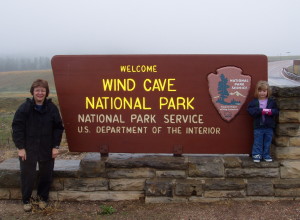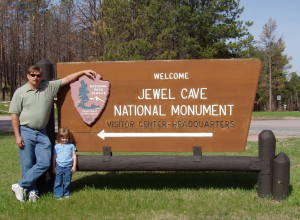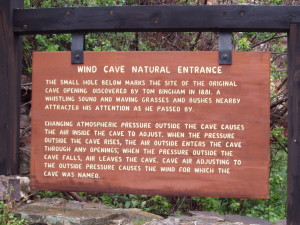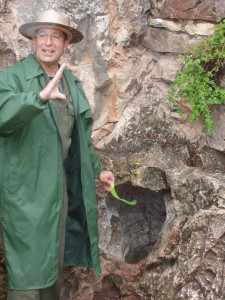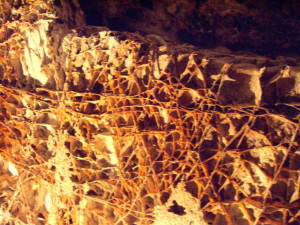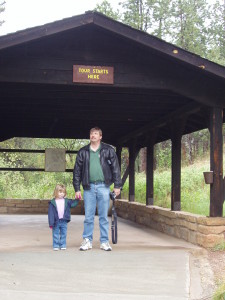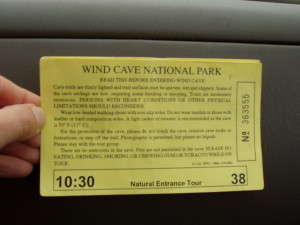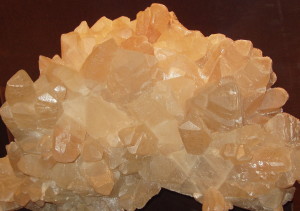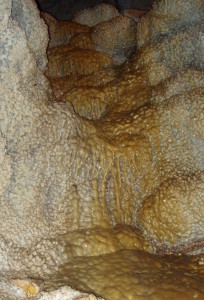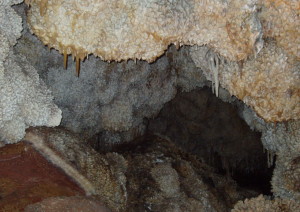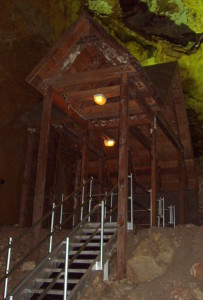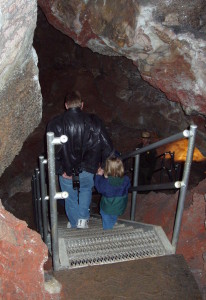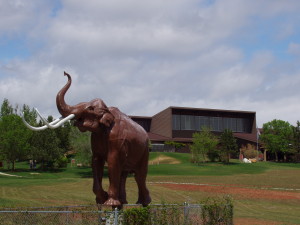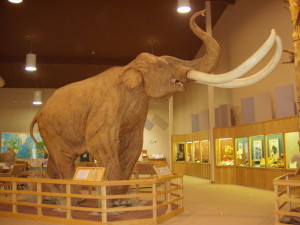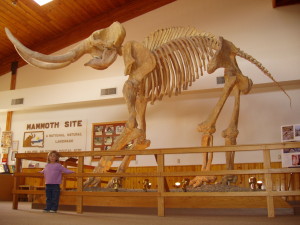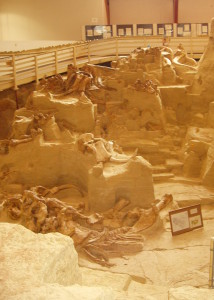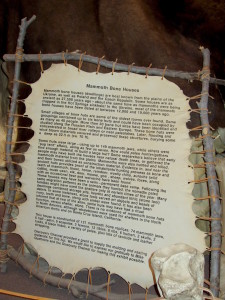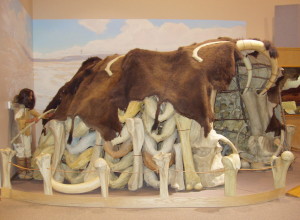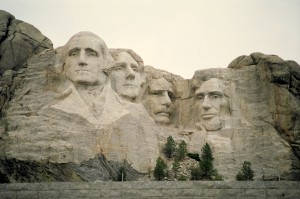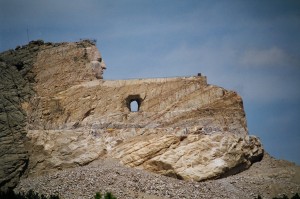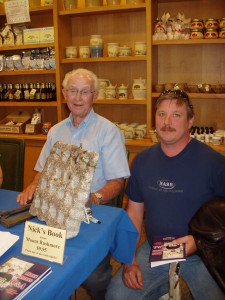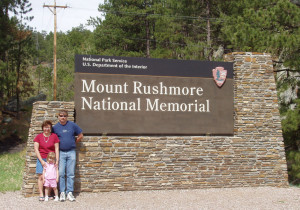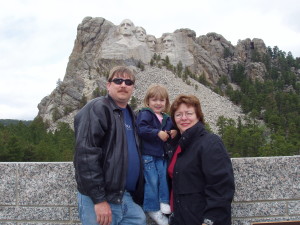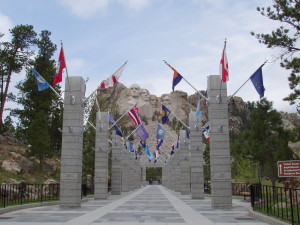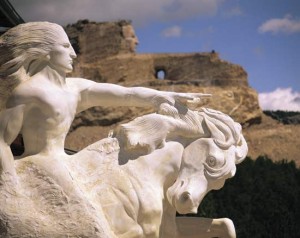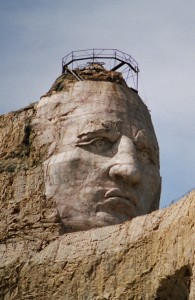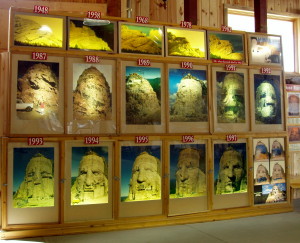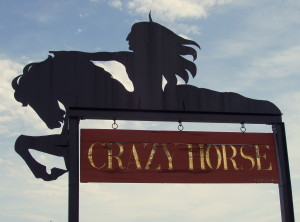Our family loves visiting caves – we’ve been to several across the United States! When we visit South Dakota back in 2004 we were excited to visit not one, but two caves.
Wind Cave National Park
Established in 1903, Wind Cave National Park is located 11 miles north of Hot Springs, South Dakota and was the first cave to be designated as a national park. Wind Cave has the sixth longest cave system in the world with almost 140 miles of explored cave passageways, on the average four new miles of cave passageways are being discovered each year. Wind Cave is known for a rare calcite formation known as boxwork.
The Lakota Native Americans that lived in the Black Hills of South Dakota had known for centuries about the unique cave that blew air out of a hole in the ground. They consider the site scared and an old legend explains that they believe it was the place where they first emerged from the underworld where they lived before the creation of the world. In 1881, the first documented “discovery” of the cave was by two brothers, Tom and Jesse Bingham. The story is that they heard the wind blowing out of a 10×14 inch hole in the ground, and when Tom looked into the hole, the wind was blowing with such a powerful force that his hat blew off his head. When Jesse returned a few days later to show some friends, he looked into the hole, found that the wind had changed directions and his hat was blown into the cave.
This unusual phenomenon of a cave that “breathes” is created by the atmospheric equalizing pressure of the air both in and outside the cave. Rapid weather changes accompanied by rapid barometric changes are common in this area of South Dakota. When the air pressure inside the cave is higher than the outside, the air flows out. When the air pressure outside the cave is lower than the outside, the air flows in. This phenomenon in smaller caves with several large openings will go unnoticed, but Wind Cave is a large cave with very few openings and that is why the “breathing” of the cave is so obvious. It is possible on the day the Bingham brothers were at the site, a storm was approaching and the atmospheric pressure would have been dropping fast outside the cave causing the cave’s higher air pressure to rush out of the cave opening creating the wind, hence the name of Wind Cave.
As previously mentioned, Wind Cave National Park is known for a rare calcite formation known as boxwork. Boxwork is an uncommon mineral formation formed by erosion rather than water evaporation. As the walls of the cave begin to erode, the most resistant veins form thin blades of calcite that emerge from cave walls or ceilings intersecting at various angles which form honeycomb or box-like patterns. 95% of the boxwood formations in the world are found in Wind Cave.
In 1890, the South Dakota Mining Company took control of the Wind Cave site hoping to find valuable minerals, after a brief time the mining proved unsuccessful and no substantial and profitable minerals were found. Then, a local family, the McDonalds, began to develop the cave for tourism. In 1892 the cave was opened for visitors, the tour fee was $1 which was a very significant amount for that time. The guides would take the tourist down into the cave and explore by candlelight but these early tours were very physically demanding and the tourists sometimes had to crawl through very narrow passages. Eventually the cave passages were widened, wooden staircases were added and a hotel was built near the entrance to the cave.
In 1903, President Theodore Roosevelt signed a bill creating the Wind Cave National Park. The surrounding area above Wind Cave proved to be an excellent prairie habitat and in 1912 a national game preserve was established and fourteen bison, 21 elk and 13 pronghorn sheep were transferred from other areas of the country. The interest in the cave and the wildlife attracted an increasing number of visitors to the park and in the 1930s the Civilian Conservation Corps (CCC) made major improvements to the cave system by adding concrete walkways, stairs and an elevator, roads and other building structures were also built in the area.
Today the Wind Cave National Park’s mission is to preserve and protect the natural resources of the 33,851 acre park. In the process of exploring additional areas of the cave system, park management has concluded that the cave is not an isolated environment. What happens above on the land in the surrounding area can greatly influence the cave and the way it continues to form, an example is that if the topography of the land is altered even slightly it might change the flow of water through the cave which will change the cave formations.
The Wind Cave Visitor Center is opened year round, except for Thanksgiving, Christmas and New Year’s Day. During the summer months, the visitor hours are expanded. All cave tours are ranger guided and there are several different types of tours that explore various parts of Wind Cave. Tickets are available at the visitor center and during the summer months there can be long lines and wait times, to avoid this inconvenience arrive early in the day to purchase tickets. Time can be spent waiting for a tour to start by a visit to the Visitor Center, there are many exhibits concerning the process of the cave formations, discovery and exploration of the cave and an 18-minute movie, “Wind Cave: One Park, Two Worlds” which is shown several times throughout the day.
For additional information regarding hours, available tours and prices please see the Wind Cave National Park page at the National Park Service website at www.nps.gov
Jewel Cave National Monument
Jewel Cave National Monument is located 13 miles west of Custer, South Dakota and it is currently the third longest cave system in the world with over 166 miles of explored cave passageway. Jewel Cave was formed when the limestone in the cave was gradually dissolved by water, the water served to enlarge the cracks that were formed when the Black Hills were formed approximately 60 million years ago. When the water that created the cave drained, the calcite formations started to form on the walls and ceilings of the cave, such as stalactites, stalagmites, flowstone and frostwork.
In 1900, Frank and Albert Michaud filed a mining claim and the brothers found a very small cave entrance, the hole was too small to get through and was enlarged several dynamite charges. When they finally entered the cave, cave passages with very low ceilings were covered with beautiful calcite crystal formations that sparkled like jewel by their lantern lights, hence the name of Jewel Cave.
When the calcite crystals proved to have little commercial value, it became apparent to the mining company that the cave was a great natural wonder and they turned their attention to creating to creating a business venture that would profit instead by making it into a tourist attraction. Over the next ten years, a wooden trail was constructed inside the cave and a hotel was built nearby. Unfortunately, few people visited this area of the Black Hills of South Dakota. (remember this was long before Mount Rushmore was built)
Eventually the hotel closed and they Michaud family sold the claim to the federal government for $750. Meanwhile, a local organization was working to having the cave protected from further development and in 1908 President Theodore Roosevelt signed a proclamation naming the Jewel Cave National Monument. In 1933, the National Park Service began administering the monument in 1933 and park rangers from the nearby Wind Cave would lead cave tours during the summer months. In 1935, the Civilian Conservation Corps (CCC) made major improvements to the cave system by adding concrete walkways and stairs, improved roads and a public campground were also built in the area.
As of 1959, less than 2 miles of cave passageway were discovered. Then, in 1961, a geologist named Dwight Deal hired a husband and wife team, Herb and Jan Conn, with the specific purpose of exploring and mapping out new sections of the cave. With the discovery of the “Scenic Area” of the cave and an additional 15 miles of cave passageways mapped, the National Park Service became very interested in developing more tour routes for public and the original boundaries of Jewel Cave were expanded. As a result, more cave passageways were explored, the cave tour routes was extended and additional ones were added. Further trail improvements were made to the existing walkways, new ones were built, an elevator was installed and a visitor center was built. Exploration continues today and more information has been discovered regarding cave formations and efforts are being made to preserve and protect this natural wonder.
Jewel Cave is open year round, expect for Thanksgiving, Christmas and New Year’s Day. The National Park Service offers three different ranger-guided tours: the scenic tour, the historic tour and a special spelunking tour through an undeveloped section of the cave. Tickets are available at the visitor center and during the summer months there can be long lines and wait times, to avoid this inconvenience arrive early in the day to purchase tickets.
For additional information regarding hours, available tours and prices please see the Jewel Cave National Monument page at the National Park Service website at www.nps.gov

